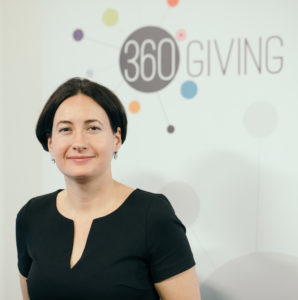Unlocking funders’ treasure chests of data
This is a repost from Civil Society Futures, where it was included as part of their final findings report.
Philanthropist Fran Perrin, from the Indigo Trust, found it hard to see who else was funding the initiatives she was interested in. She felt she was “giving in the dark” as she couldn’t get the information she needed to make strategic decisions. She wondered if the sector could be more data-driven and more accountable.

Fran Perrin, founder of the Indigo Trust and 360Giving
Fran was inspired by other open data initiatives such as Citymapper, which uses real-time transport data shared openly by cities across the world. She wanted to test if something similar could be developed for UK grantmaking. Was there a way to bring funding information together so that anyone could quickly see what’s being funded in a particular community or sector?
Testing an idea
To find out, in 2014 Fran brought together some like-minded funders and technical experts to develop a standard format for sharing grants data – and 360Giving was born. We set to work looking at the basic information people want to know about grants – who to, what for, how much, when, etc. We found that nearly all funders collect this information and it would be fairly simple to create a standard way of sharing it so everyone could benefit. Think of it as books in a public library, all organised in the same way.
After a bit of testing, the 360Giving Standard became a reality with some leading funders taking the plunge by sharing their data.
At first there was a bit of nervousness – will they be criticised for some of the activities? What if a journalist misunderstands? But that soon wore off. There have been no scandals. Most of the information was already available on funders’ websites and in their annual reports. The difference is that it’s now much easier to find, use and compare.
In fact, funders tell us they’ve found sharing their grants data has made them think more broadly about what information they collect and how they use it. What questions does it help answer? How can they explain more clearly what they do and don’t fund and why?
There are now nearly 100 funders sharing over £25 billion worth of grants openly. These range from charitable trusts and family foundations, corporate funders, local authorities and central government departments. All the data can be accessed, compared, visualised and downloaded by anyone who wants to better understand how civil society is funded. This saves days of wasted time and effort trawling hundreds of websites and documents trying to find out who is funding what.
Never before has this information been available so easily and for free. It’s a quiet revolution, and it’s opening up a goldmine of information that will benefit civil society.
Learning
Back in 2014, we weren’t sure if this idea would fly. 360Giving has come a long way since then and learned that:
1. Funders are generally low-tech, but recognise the benefits of sharing their data
In a climate of local authority cuts, increased scrutiny of charities and the desire to champion philanthropic giving, funders were quick to see the benefits of sharing their data and worked with us. Most need a little help preparing it but they are keen to learn and have lots of questions about how they can work more with data.
2. It’s a bit scary the first time
Funders are sometimes nervous the first time they share their data openly. What if people misunderstand their funding model or they are inundated by applications? This hasn’t happened though. Instead, funders tell us the process of opening up their data has led them to look more closely at what data they are collecting, where and how they share it and what other data can support their work. They have also seen how the data can support their peers with their own research.
3. Most people want deeper stories and evidence, not raw data
In fact, most people don’t know how to work with raw data; but they’re interested in the stories and evidence hidden within it. This is why we have developed platforms such as GrantNav and Beehive Giving, to help non-techies use the information too.
4. The importance of testing and working in partnership
To make sure we were getting honest feedback on what is and isn’t working and were not just serving one community’s needs, the team worked with a variety of data users. Fundraisers, researchers, policy makers and journalists want this information too; for example, to look at funding to deprived areas or to better understand different communities.
What the future could look like
In an ideal world, all grants data would be shared openly, be it from government bodies, trusts and foundations, corporate funders, the many hidden charities or even individual donations made online. This would help follow the flows of money going to civil society activities, but also to better identify need, gaps and overlaps.
If all the flows of money going to these different organisations were clearer it would help identify activities across the country. It would also help answer some of the trickier questions such as: What has been the impact of cuts to local authority grants? What impact has this funding had in this community? What has been done previously that we could learn from?
Whilst no perfect world of data exists, organisations are encouraged to start sharing the data they have and to build from there. They’ve got nothing to lose, and civil society has everything to gain.
